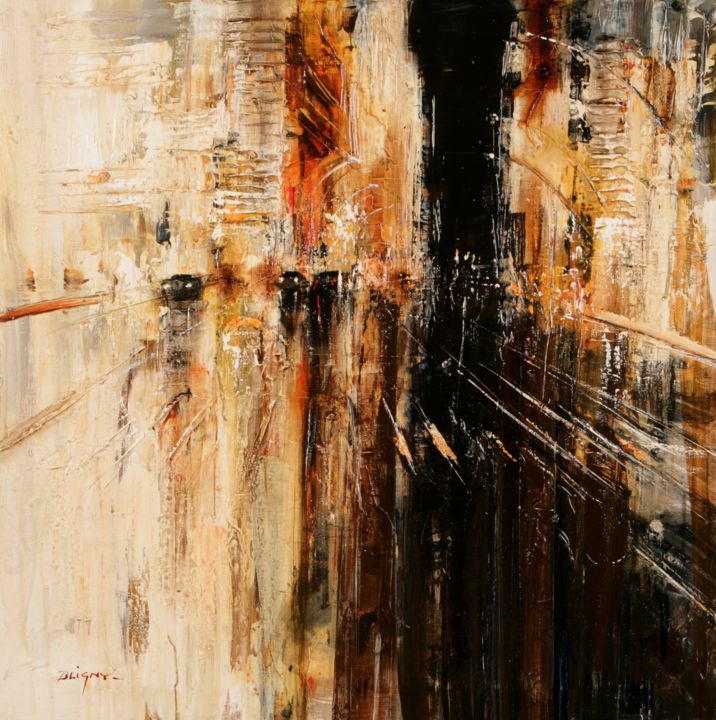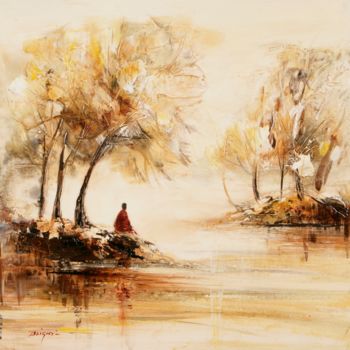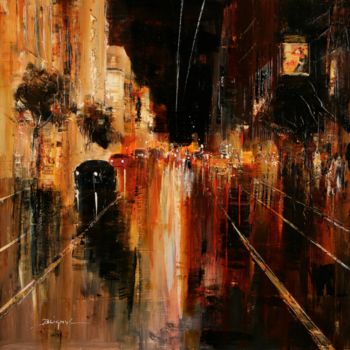"Lumière et vitesse à San Francisco" 60x60cm (2017) Ζωγραφική από Bligny
-
Αυθεντικά έργα τέχνης
Ζωγραφική,
στο Καμβάς
- Διαστάσεις Ύψος 23,6in, Πλάτος 23,6in
BLIGNY – traduction du texte de Patrice de la Perrière
The painting of Jean-Claude Bligny is a development both pictural and spiritual. In his painting the artist endeavours to make us conscious that nature is the bedrock of life and it is for us to seek there that which is to be revealed. Behind the landscape images that the artist asks to be scrutinised, Bligny instils personal thought generating questions that in themselves have underlying answers. In a certain fashion Bligny pays attention to and notes the features which inspire the landscapes and architectural transcripts so that we can also appreciate them.
When it is understood that Bligny has been captivated by Buddhist philosophy and teaching, one better understands perhaps that sobriety which is elevated to a virtue, affording a furtherance along the Way. It pleases me to imagine that the pencils and paintbrushes he uses ressemble a Samuraï sword. Because of that I cite this phrase which comes from a verse written by the Zen Master Mugaku (1226-1286) ‘The sword cleaves the Spring breeze, in a lightning flash’ . So with the help of a paintbrush Bligny renders the breeze as an emblem and reveals the invisible.
When Bligny explores landscapes, be they rural or urban, he doesn’t act like a hunter, he doesn’t track them, but rather waits for them to speak to him and that the desire to register a view infinite and eternal on the canvas imposes itself on him. All along the pathway of the painter intangible meetings nourish him and give him the opportunity to realise that which he has seen and felt.
Buddhist law, the Dharma, allows one to progress inwardly and see the ‘sacred’ which resides in each living being as well as in the spirit of nature. As the Dalaï Lama wrote ‘ The true practice of Dharma is interior ; it is a peaceful spirit, open and generous, a spirit that one has known how to master, which is completely under control’. It is that which brings us closer to what the Chinese sages say in speaking about traditionnal painting, which, according to them, is the result of the complementarity of ‘emptiness and fullness’.
In contemplating this dissertation on Jean-Claude Bligny’s work, we gain a broader knowledge of the personality of an exceptional artist and certainly a more intimate and intrinsic perception of the way that he invites us to travel with him .
!
Bligny
Les Secrets
de l'Univers
0 · UDA N° 189
L'œuvre peint de Jean-Claude Bligny est un cheminement à la fois pictural et spirituel. Par l'acte de peindre l'artiste
s'efforce de nous faire prendre conscience que la nature est le socle de la vie et qu'il nous appartient d'aller au devant de ce qu'elle a à nous dévoiler. Derrière l'image des paysages qu'il nous offre à voir, Bligny installe une pensée propre à susciter des questionnements contenant en eux-mêmes des réponses sous-jacentes. D'une certaine manière, Bligny écoute et remarque les signes que lui font ces paysages, les transcrits en les architecturant afin que nous puissions nous aussi en prendre la mesure.
Lorsque l'on sait que Jean-Claude Bligny est séduit par la philosophie et l'enseignement bouddhiste, on comprend peut-être mieux le dépouillement qu'il érige en vertu permettant d'avancer sur le Chemin. Il me plaît de penser que les pinceaux et brosses qu'il utilise sont semblables au
sabre du samouraï. C'est pour cela que je citerai cette phrase sortie d'une stance écrite par Mugaku (1226-1286), maître du Zen : « Le sabre fend la brise printanière, le temps d'un éclair ! » Ainsi, à l'aide du pinceau, Bligny parvient à transformer la brise en signe et à révéler l'invisible. Lorsque Bligny recherche les paysages ruraux ou urbains, il n'agit pas comme un chasseur, il ne les traque pas mais attend plutôt qu'ils lui parlent et que le désir d'inscrire une vision infinie et éternelle sur la toile s'impose à lui. Tout au long de la voie du peintre, les rencontres immatérielles le nourrissent et lui donnent la chance de manifester ce qu'il a vu et ce qu'il ressent.
La loi bouddhique, le Dharma, permet d'avancer et de voir la nature de l'esprit qui réside en chaque être vivant, ainsi que l'esprit de la nature. Comme l'a écrit le Dalaï Lama, « La vraie pratique du Dharma est intérieure ; c'est un esprit paisible, ouvert

-
Ιθαγένεια:
ΓΑΛΛΊΑ

- Ημερομηνία γεννήσεως : άγνωστη ημερομηνία
- καλλιτεχνική τομείς:
- Ομάδες: Σύγχρονοι Γάλλοι Καλλιτέχνες






